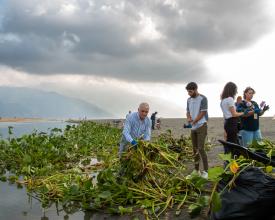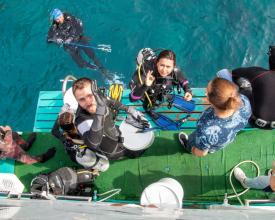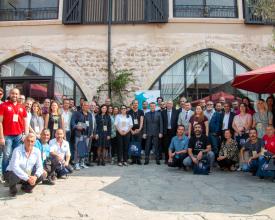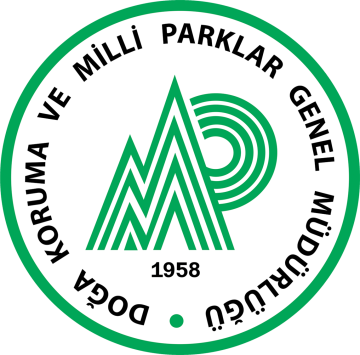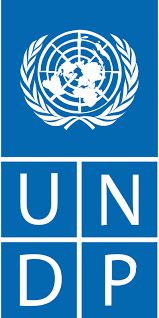
Lutte contre les espèces marines exotiques envahissantes dans les mers turques
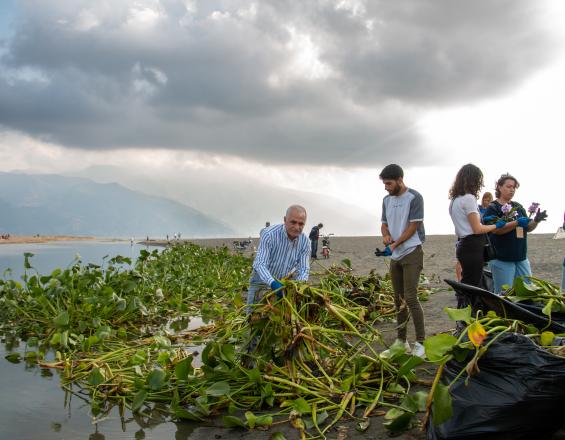
La lutte contre les espèces exotiques envahissantes (EEE) est une question d'importance mondiale en raison de leurs graves incidences négatives sur les systèmes écologiques, l'économie, la santé publique et le bien-être de la population. La géologie, la géographie et le climat uniques de la Turquie en font un haut lieu de la biodiversité, tant sur terre que dans les mers qui bordent le pays sur trois côtés. Cependant, cette richesse naturelle est menacée par 872 espèces invasives différentes qui se sont introduites au cours des dernières décennies en raison de l'ouverture du canal de Suez, du déversement des eaux de ballast des navires en transit et de l'impact du changement climatique.
Pour aider le pays à faire face à cette menace, la Direction générale de la conservation de la nature et des parcs nationaux au sein du ministère de l'Agriculture et des Forêts de Türkiye met en œuvre l'initiative "Addressing Invasive Alien Species Threats at Key Marine Biodiversity Areas" en collaboration avec le PNUD. L'initiative est soutenue par un financement de 3,3 millions de dollars US du FEM. Le projet est mis en œuvre entre le 19 octobre 2018 et le 19 avril 2025.
Contexte
Défis à relever
La Turquie abrite un grand nombre et une grande variété d'espèces dans ses divers habitats marins et côtiers. Les écosystèmes marins, de par leur biodiversité, leurs fonctions et services écosystémiques, fournissent de nombreuses valeurs et avantages environnementaux, sociaux et économiques. Toutefois, la biodiversité marine est menacée par les espèces exotiques envahissantes (EEE) qui perturbent les réseaux alimentaires marins et entraînent une dégradation de la biodiversité marine. Elles s'attaquent en particulier aux espèces indigènes, leur font concurrence pour l'espace et la nourriture, modifient et détruisent l'habitat où elles s'établissent et sont porteuses de parasites et de maladies.
Certaines EEE marines sont toxiques et dangereuses pour la santé humaine, et certaines peuvent transmettre des maladies et des parasites aux espèces indigènes. Les espèces telles que les méduses représentent un danger pour les nageurs et les plongeurs, ce qui a un impact négatif sur la pêche et le tourisme, qui sont des moyens de subsistance essentiels pour les populations locales.
En Turquie, le coût des EEE pour l'économie du pays a été estimé à 4,1 milliards de dollars entre 1960 et 2022, mais il a été prévu que ce chiffre serait bien plus élevé si l'on tient compte des coûts non enregistrés.
Emplacement
Traiter
Résumé du processus
Le succès du projet MarIAS, mis en œuvre entre le 19 octobre 2018 et le 19 avril 2025, est ancré dans l'interconnexion de ses composantes stratégiques. La formulation d'un cadre politique national robuste sur les EEE a fourni l'infrastructure juridique et institutionnelle nécessaire, préparant le terrain pour des stratégies réalisables et favorisant l'engagement des parties prenantes. Cette base a été complétée par des activités globales de renforcement des capacités, qui ont permis aux parties prenantes de se prendre en charge grâce au partage des connaissances, à l'éducation et au développement d'outils tels que la base de données TurIST. Ces efforts ont été renforcés par le pilotage de plans de gestion durable des espèces exotiques envahissantes et d'événements communautaires combinant des solutions pratiques et des initiatives de sensibilisation du public. Ensemble, ces éléments ont créé un système cohérent où la politique, les capacités et la mise en œuvre se renforcent mutuellement pour produire des résultats durables à long terme dans la lutte contre les espèces exotiques envahissantes et la restauration des écosystèmes.
Blocs de construction
Formulation d'un cadre politique national efficace sur les espèces exotiques envahissantes
Le projetMarIAS (Addressing Invasive Alien Species Threats at Key Marine Biodiversity Areas) s'est engagé à améliorer l'infrastructure juridique et institutionnelle du pays pour contrer la menace des espèces exotiques envahissantes. Dans cette optique, un "règlement sur la prévention et la gestion de l'introduction et de la distribution des espèces exotiques envahissantes" a été rédigé conformément à la législation de l'UE, et un comité national sur les espèces exotiques envahissantes ainsi que des groupes consultatifs techniques sur les espèces exotiques envahissantes ont été créés sous l'égide de l'actuel conseil national de coordination de la biodiversité.
Pour faire face aux menaces potentielles à long terme, le projet a également permis l'élaboration de la première stratégie et du premier plan d'action de la Turquie pour lutter contre les espèces exotiques envahissantes et restaurer les écosystèmes qu'elles ont endommagés. La nouvelle stratégie, qui comprend 11 composantes couvrant 57 actions à réaliser entre 2024 et 2035, est alignée sur les meilleures pratiques régionales, nationales et internationales.
L'objectif (mission) de la stratégie est de coordonner et de coopérer aux niveaux national et international sur la mise en œuvre et les mesures concernant des questions telles que l'introduction, la détection, la surveillance, le contrôle et la prévention/atténuation des espèces exotiques envahissantes. La stratégie a été préparée dans le cadre des trois objectifs principaux de cette mission :
- Prévenir l'introduction d'EEE nuisibles à tous les secteurs, détection précoce, intervention rapide, surveillance, lutte et prévention des dommages afin de protéger la biodiversité, les services écosystémiques, l'économie et la santé publique ;
- Restaurer ou améliorer les habitats et les écosystèmes envahis ;
- Soutenir tous les efforts dans le domaine de la lutte contre les EEE à l'échelle internationale et nationale et accroître l'efficacité de la Turquie à cet égard.
La coordination de la Stratégie nationale sur les espèces exotiques envahissantes et du Plan d'action sera assurée par le Comité national sur les espèces exotiques envahissantes.
Facteurs favorables
La stratégie et le plan d'action ont été préparés selon une approche participative et conformément aux stratégies mondiales et européennes, en tant que premier document fondamental de la Turquie sur les EEE. La participation active des principales organisations gouvernementales, des organisations internationales, des administrations locales et des organisations d'utilisateurs telles que les coopératives de pêche, les associations de propriétaires de bateaux commerciaux et de yachts, ainsi que des représentants du secteur privé, des organisations non gouvernementales nationales et des universitaires, s'est avérée être un facteur essentiel pour le développement d'une stratégie et d'un plan d'action nationaux bien conçus et réalistes.
Leçon apprise
L'élaboration d'une nouvelle législation et de nouvelles stratégies nécessite l'acceptation de toutes les parties prenantes, ce qui constitue un processus extrêmement difficile. Plusieurs entretiens animés par des professionnels, des réunions de groupes de discussion et des ateliers ont été organisés entre les parties prenantes, en plus de l'implication de plusieurs consultants spécifiques afin de garantir une prise de décision éclairée. Plus de dix consultations ont eu lieu pendant cinq ans, presque depuis le début du projet, y compris l'analyse des lacunes juridiques et la rédaction du document juridique. Les techniques de résolution des conflits peuvent également s'avérer utiles à certains moments.
Renforcement des capacités, systèmes de partage des connaissances et de l'information pour faire face aux menaces posées par les espèces exotiques envahissantes
Le renforcement des capacités, l'échange de connaissances et d'informations pour faire face aux menaces liées aux espèces exotiques envahissantes sont d'une importance capitale pour la protection des écosystèmes marins.
Le projet a lancé des activités de renforcement des capacités à l'échelle nationale par le biais d'une conférence scientifique, organisée du 21 au 23 novembre 2022 à Antalya, afin de discuter de la manière de surmonter l'impact négatif des espèces marines exotiques envahissantes sur l'écologie, les moyens de subsistance, l'économie et la santé publique en Turquie. Réunissant toutes les parties prenantes travaillant dans ce domaine, la conférence a servi de plateforme pour partager des informations sur les effets écologiques et économiques des espèces marines envahissantes et sur les activités visant à les éradiquer, les atténuer et les contrôler dans le pays et au niveau mondial. Les présentations d'experts renommés se sont concentrées sur la destruction causée par le poisson-lion, la jacinthe d'eau, le bulot et d'autres espèces. Cette conférence a également constitué une étape importante dans l'élaboration d'une politique nationale de lutte contre ces espèces, car les solutions discutées lors de la conférence ont permis d'améliorer la résilience des écosystèmes marins et côtiers. Le projet MarIAS a également organisé un symposium international de suivi sur la gestion des eaux de ballast et des salissures biologiques dans le cadre de la prévention et du contrôle des espèces exotiques envahissantes du 28 au 30 novembre 2023 à Antalya.
Le système national turc de données et d'informations sur les espèces exotiques envahissantes (TurIST) a été conçu conformément aux conclusions des conférences et des consultations des parties prenantes et lancé en 2024 sous la forme d'une base de données couvrant 181 espèces différentes, afin d'aider les scientifiques et les décideurs politiques en montrant où les espèces exotiques envahissantes se rassemblent et en mesurant les dommages écologiques, économiques et sociaux qu'elles causent. TurIST devrait faciliter la coopération internationale pour permettre une action commune visant à résoudre le problème commun. La base de données en temps réel recevra en permanence des données des pêcheurs et des ONG locales afin de fournir aux experts et aux décideurs politiques des informations actualisées.
Entre-temps, des lignes directrices sur les mécanismes de biosécurité et de quarantaine ont été élaborées pour les secteurs critiques, et des formations en série ont été organisées pour les pêcheurs, les plongeurs et les représentants du secteur du transport maritime, avec la participation des institutions gouvernementales, des garde-côtes turcs, des ONG et des communautés locales sur les sites pilotes, y compris les pêcheurs, l'Union centrale des coopératives de pêche, les plongeurs, l'aquaculture, la navigation commerciale et les représentants du secteur du transport maritime, ainsi que l'Association des femmes de la pêche. Les formations visaient à accroître les connaissances et la sensibilisation sur les menaces, les impacts, les mesures d'atténuation et les meilleures pratiques des EEE.
Le projet a également investi dans la sensibilisation aux espèces exotiques envahissantes dans les écoles et dans la préparation de plans de cours pour les écoles primaires et secondaires. Au cours de l'année scolaire 2022-2023, environ 9 000 élèves travaillant avec 300 enseignants ont été touchés, mettant en évidence les effets néfastes causés par les espèces exotiques envahissantes marines sur l'écologie, l'économie et la santé publique.
Facteurs favorables
Les conférences ont rassemblé des scientifiques et des experts, ainsi que des représentants d'institutions gouvernementales, du secteur public, d'universités, du secteur privé et de la société civile, et ont permis des échanges de connaissances entre les représentants des autorités chargées de la biodiversité, du changement climatique et du développement durable. Compte tenu du fait que le manque massif de données est l'un des principaux obstacles à la résolution des problèmes liés aux espèces exotiques envahissantes, les conférences scientifiques ont créé un environnement propice et des opportunités de collaboration à long terme et de partage de données entre la communauté scientifique et les décideurs.
L'inclusion de diverses parties prenantes a permis l'accès et le bon déroulement des activités de renforcement des capacités à des échelles et dans des lieux multiples.
Leçon apprise
Il est très important que les gens apprennent dès l'école primaire que tous les citoyens ont un rôle critique à jouer pour s'assurer que le public est guidé pour donner à cette question l'importance qu'elle mérite, en empêchant l'entrée et en contrôlant la propagation des espèces exotiques envahissantes. Pour générer un maximum d'avantages et un effet multiplicateur dans le temps et le budget limités, le projet MarIAS s'est concentré sur la formation des enseignants pour des résultats plus durables et a collaboré avec une ONG nationale experte à cette fin.
Les contributions d'ÖRAV (Teachers Academy Foundation), l'organisation non gouvernementale qui soutient le développement personnel et professionnel des enseignants en Turquie depuis 2008, se sont avérées très efficaces dans le cadre de l'adoption rapide, de l'appropriation, de la mise en œuvre réussie et de la diffusion du programme de formation préparé pour les enseignants des écoles primaires et secondaires dans les régions pilotes du projet.
Ressources
Investissement dans la gestion durable, la prévention, l'éradication et le contrôle des EEE, ainsi que dans la restauration des habitats dégradés par les EEE dans les principales zones marines et côtières.
Il est essentiel de tester et de piloter une variété de stratégies de gestion et de contrôle des EEE pour acquérir de l'expérience et du savoir-faire. À cette fin, des cadres de gestion des EEE, c'est-à-dire des plans de gestion des EEE, ont été élaborés dans quatre sites pilotes du projet. La mise en œuvre des plans de gestion a commencé à partir des îles Ayvalık en 2023 et sera achevée sur tous les sites pilotes d'ici la fin de 2024.
Le projet MarIAS a également développé des programmes d'incitation à la récolte pour les populations de poisson-lion d'origine indo-pacifique (Pterois miles), d'étoile de mer de l'Atlantique (Asterias rubens), de poisson-globe (Lagocephalus sceleratus) et de jacinthe d'eau (Eichhornia crassipes), offrant des solutions sur la façon de les contrôler et de les intégrer dans l'économie. Dans le cadre de la mise en œuvre de ces programmes d'incitation à la récolte, un concours de pêche et un événement gastronomique pour le poisson-lion, un concours de plongée pour collecter des étoiles de mer et une activité communautaire pour l'élimination de la jacinthe d'eau dans la rivière Asi et le long de la côte méditerranéenne à Samandağ ont été menés à bien. Le derby du poisson-lion à Keldağ a été suivi d'une dégustation de différentes recettes à base de poisson-lion, dans le but de populariser la chasse et la consommation de poisson-lion parmi les habitants de Hatay. Les plongeurs locaux ont participé à un tournoi à petite échelle, concourant pour collecter le plus d'étoiles de mer possible sur les côtes des îles Marmara, et les gagnants ont été récompensés par un ordinateur de plongée, un sac de plongée et une torche de plongée. L'opération communautaire d'élimination des jacinthes d'eau visait les jacinthes d'eau, qui bloquent les voies d'eau et les canaux et empêchent la lumière du soleil et l'oxygène d'atteindre la colonne d'eau et les plantes submergées en raison de leur reproduction et de leur propagation très rapides, ce qui a un impact négatif sur les transports, le tourisme et les activités de pêche et entraîne une destruction importante de l'écosystème ainsi qu'une diminution significative de la biodiversité.
Facteurs favorables
Le principal facteur qui a permis d'investir dans la gestion durable des EEE est la disponibilité de fonds du FEM pour cette cause, ce qui a encouragé et renforcé la volonté et l'adoption rapide d'institutions gouvernementales telles que la Direction générale de l'aquaculture et de la pêche dans la lutte contre les EEE, en particulier le poisson-globe toxique et le poisson-lion.
Un processus engagé et inclusif pour l'implication des parties prenantes et la collaboration active d'une ONG nationale experte (Nature Research Society) dans la planification de la gestion des zones protégées et les plans d'action pour les espèces pour le développement et la mise en œuvre accélérée des plans de gestion des EEE des sites pilotes a également favorisé un processus qui a été accepté et formellement reconnu par tous les acteurs impliqués.
Leçon apprise
La participation des communautés côtières locales est importante pour sensibiliser le public, et les événements collectifs et ludiques peuvent également constituer des solutions à court terme pour contrôler la population d'espèces exotiques envahissantes. En outre, ces événements contribuent à sensibiliser les communautés côtières aux espèces envahissantes et aux menaces qu'elles peuvent représenter pour la biodiversité locale et les moyens de subsistance.
Impacts
Faisant partie des pays les plus touchés et signataire de nombreux traités régionaux et internationaux visant à protéger la nature, la Turquie joue un rôle de premier plan dans la lutte contre les espèces exotiques envahissantes. Les activités législatives, préventives et de sensibilisation menées dans le cadre du projet MarIAS ont déjà établi des normes pour les efforts à long terme du pays en vue d'éliminer ce problème majeur et ont permis d'obtenir les résultats suivants :
- Mise en place d'une législation et d'une politique nationales sur la prévention et la gestion des EEE, ainsi que de systèmes de surveillance et de gestion des données.
- Gestion efficace des EEE sur 94 800 ha (sites pilotes) et amélioration du suivi et de l'intervention
- Augmentation des fonds alloués à la lutte contre les EEE
Les effets du projet MarIAS devraient se multiplier à mesure que se poursuit la lutte efficace contre les espèces exotiques envahissantes pour la protection des écosystèmes marins et de la biodiversité, la protection des moyens de subsistance contribuant à la santé et au bien-être de l'homme, la préservation des avantages sociaux et culturels offerts par les écosystèmes marins aux êtres humains, et la prévention des coûts et des pertes économiques causés par les espèces exotiques envahissantes.
Bénéficiaires
Les parties prenantes du projet comprennent les institutions publiques, les unités provinciales, les gouvernements locaux, les universités, les ONG, les pêcheurs et les communautés. Principales institutions concernées : Ministères des transports, de l'environnement, de la santé, du tourisme, du commerce, ainsi que les unités de sécurité.
